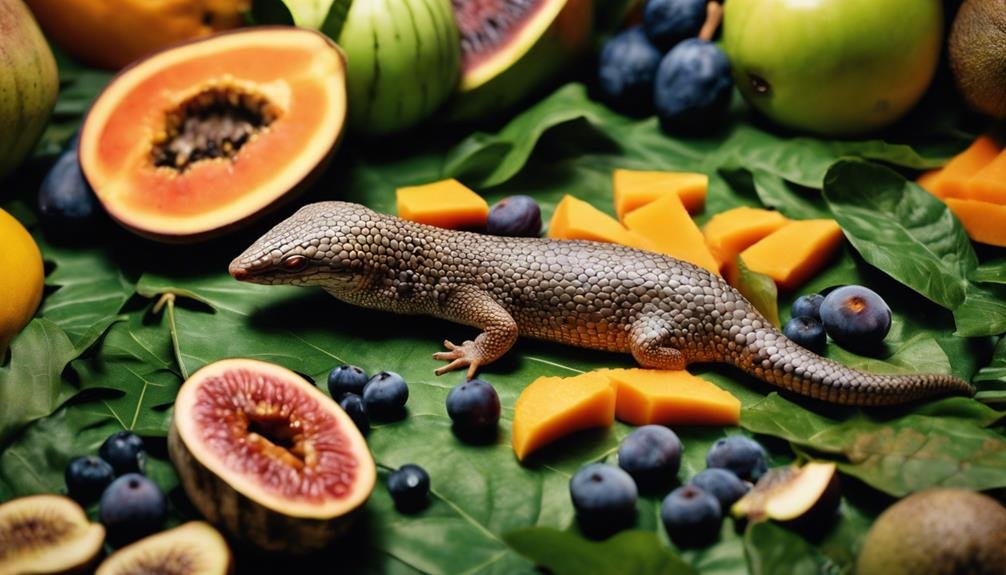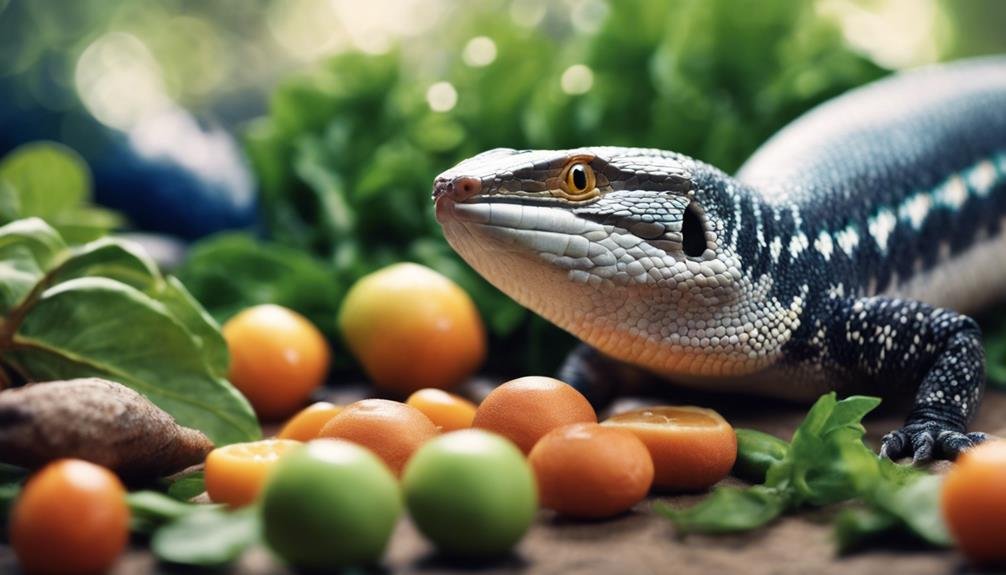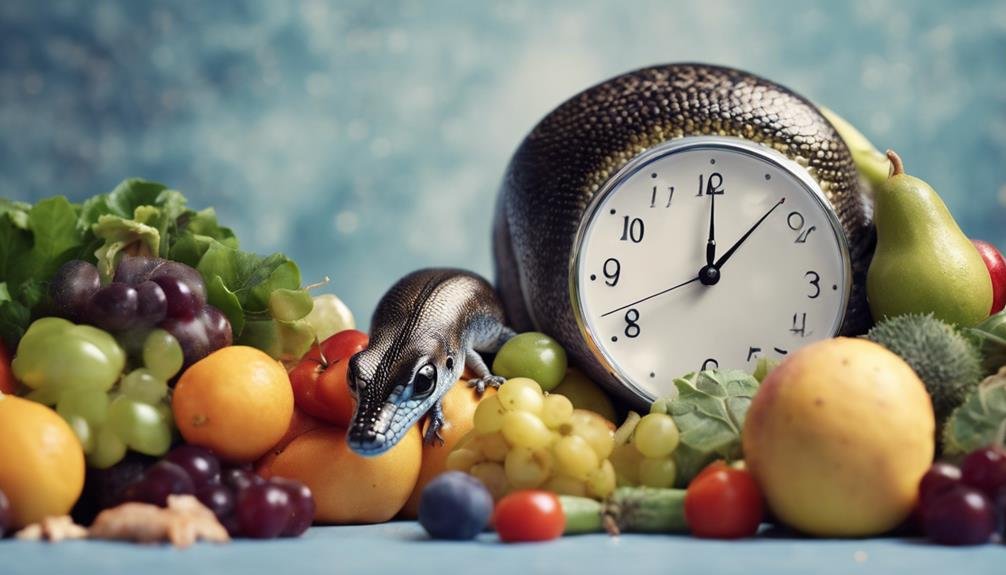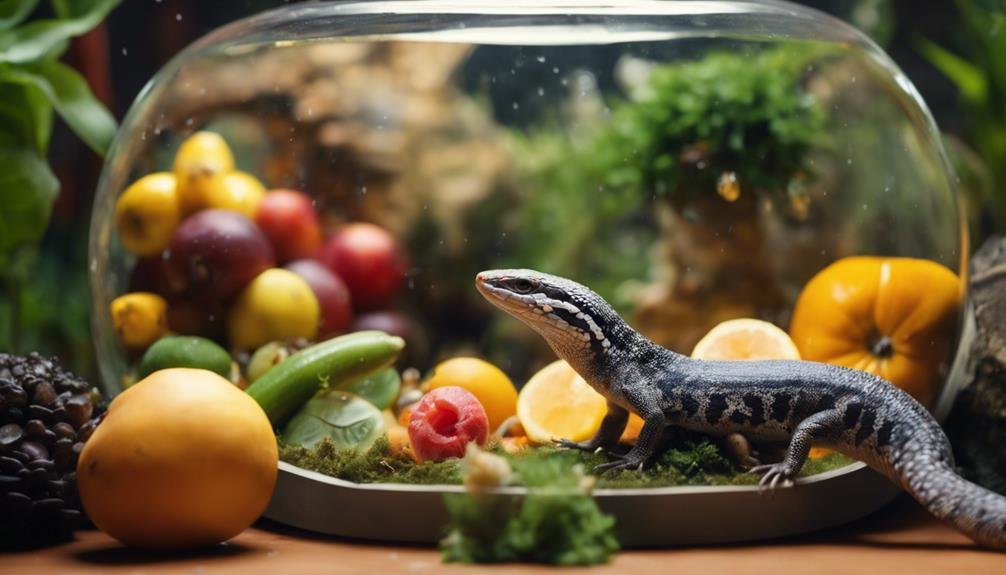You're likely aware that blue tongue skinks have a varied diet, but do you know the specifics that guarantee their health and vitality? From protein sources including insects and meats, to a plethora of vegetables and certain fruits, their dietary needs might seem straightforward at first glance. However, the nuances in their nutrition, such as the importance of calcium powder dusting and the dangers of citrus fruits, are crucial. As you explore further, you'll discover why certain foods are favored and others are to be strictly avoided, shaping a diet that could greatly impact your skink's health and longevity.
Key Takeaways
- Blue Tongue Skinks eat a variety of foods including insects, meats, and vegetables.
- Their diet should include protein sources like crickets, snails, and cooked chicken, supplemented with calcium powder.
- Vegetables like squash, green beans, and carrots are optimal, while avoiding toxic plants such as avocado and eggplant.
- Fruits like berries can be offered, but citrus fruits should be avoided.
- Hydration is vital, so providing fresh water daily is essential for their health.
Protein Sources
In order to promote their best growth and health, blue-tongued skinks require a variety of protein sources, including insects and meats, in their diet. You've got to understand that protein is crucial for their development, and not just any protein will do. It's important to offer them a range of insects like crickets, snails, and roaches, alongside meats such as chicken, beef, and liver. But here's the kicker: these proteins need a boost. Dusting your skink's insects with calcium powder ensures they're not just getting protein, but also a meal balanced with essential nutrients.
Moreover, making sure insects are gut-loaded amplifies their nutritional value, making every bite count. Variety isn't just the spice of life; it's a cornerstone of your skink's health. Incorporating different proteins like butterworms, canned cat food, and cooked meats into their diet prevents nutritional deficiencies. Remember, a balanced diet for your blue-tongued skink isn't complete with protein alone, but it's a crucial component. Mixing up their protein sources ensures they're getting a broad spectrum of nutrients necessary for a thriving life.
Recommended Vegetables
When it comes to feeding your blue-tongued skink, choosing the right vegetables is crucial for their health. You'll want to focus on ideal vegetable choices that provide essential nutrients, while also avoiding toxic plants that could harm your pet.
This section will guide you on which vegetables to include in their diet and the ones to avoid, ensuring your skink thrives.
Optimal Vegetable Choices
Your blue tongue skink's diet thrives with excellent vegetable choices like butternut, acorn, and summer squash. Including green beans, prickly pear, and mulberry leaf in their meals contributes to their health and well-being. Don't forget to occasionally mix in broccoli, bell peppers, carrots, and sweet potatoes for variety.
These vegetables, cut into smaller pieces and mixed with greens, can entice even the pickiest eaters. It's important to provide a wide range of vegetables to guarantee a balanced and nutritious diet. Remember, offering a diversity of vegetables not only caters to their nutritional needs but also keeps their meals interesting and enjoyable.
Stick to these recommendations, and you'll have a happy and healthy blue tongue skink.
Avoiding Toxic Plants
To ensure your blue-tongued skink's health, it is crucial to avoid toxic plants like avocado and onion. Instead, focus on providing a diet rich in safe vegetables and greens that contribute to their well-being. Here's a quick guide to what you should and shouldn't feed them:
| Safe Vegetables | Safe Greens | Toxic Plants |
|---|---|---|
| Butternut Squash | Dandelion Greens | Avocado |
| Green Beans | Hibiscus | Onion |
| Bell Peppers | Plantain | Eggplant |
| Carrots | Rhubarb | |
| Tulips |
Safe Fruits


Incorporating safe fruits like blueberries, blackberries, raspberries, and strawberries into your blue-tongue skink's diet can greatly enhance their intake of essential vitamins and nutrients. These fruits not only offer a delightful variety but also guarantee your skink receives a balanced mix of what it needs for a healthy life. Including such safe fruits is vital in providing a diet rich in vitamins and nutrients, specifically tailored for the unique needs of your blue-tongue skink.
You can also offer occasional treats like bananas, apples, pears, and melons to add even more diversity to their meals. However, it's important to remember that these should be given in moderation to maintain a balanced diet. Avoid citrus fruits like lemons or oranges, as these aren't suitable for your skink and can cause health issues.
Toxic Foods to Avoid
Be sure to keep your blue-tongue skink away from toxic foods such as avocado, onion, eggplant, rhubarb, and tulips to safeguard their health. These foods can be harmful and potentially toxic, leading to serious health issues if ingested. As a responsible owner, it's important to be aware of what can be dangerous to your pet's well-being.
Here's a quick list of key points to remember:
- Avocado: Contains substances that can cause heart failure and respiratory distress in blue-tongued skinks.
- Onion and Garlic: These can lead to anemia or gastrointestinal irritation, both of which pose a significant threat.
- Eggplant: Parts of the plant contain solanine, which is toxic to many reptiles, including blue-tongued skinks.
- Rhubarb: Contains oxalic acid, which can lead to kidney failure.
Avoiding these toxic foods is essential for maintaining your blue-tongued skink's health and preventing any unnecessary risk. Always opt for a safe and appropriate diet, steering clear of anything known to be harmful to reptiles. This proactive approach ensures your pet enjoys a long, happy, and healthy life.
Supplemental Nutrition


In addition to their basic diet, you'll want to make sure your blue-tongued skink receives the appropriate supplemental nutrition for its health. This includes the importance of vitamin supplements and the crucial role of calcium powder, which are essential for their overall well-being.
Additionally, remember that hydration is vital for maintaining their health and preventing nutritional deficiencies.
Vitamin Supplements Necessity
To guarantee your blue-tongued skink remains healthy, you'll need to provide vitamin supplements like calcium and multivitamin powders. Here's how to effectively use these supplements:
- Choose the Right Calcium Powder: If your skink's habitat has UVB lighting, opt for calcium without D3. Otherwise, calcium with D3 is necessary.
- Incorporate Multivitamin Powder: Maintain a balanced diet by adding a multivitamin powder to your skink's meals.
- Avoid Over-Supplementing: Too much of a good thing can be harmful. Stick to recommended dosages to prevent health issues.
- Gut-Load Insects: Before feeding insects to your skinks, gut-load them for 24-48 hours to enhance their nutritional value.
Calcium Powder Importance
Why should you consider calcium powder an essential part of your blue-tongue skink's diet?
This supplement is important for preventing metabolic bone disease (MBD), ensuring your skink maintains robust bone health. When UVB lighting might be limited, supplementing with calcium powder guarantees your skink receives the necessary calcium levels.
However, it's important to avoid over-supplementing, as this can lead to hypercalcemia, a condition that's harmful to your pet's health. By gut loading insects with calcium powder before feeding, you greatly enhance the insects' nutritional value.
Hydration and Health
Maintaining your blue-tongued skink stays properly hydrated is just as crucial as providing it with the right nutrients for best health. Here's how you can make sure your skink is healthy and thriving:
- Always provide access to clean, fresh water to sustain hydration and overall health.
- Incorporate calcium powder into their diet to support bone health and prevent metabolic bone disease.
- Use multivitamin powder sparingly, following recommended guidelines to avoid over-supplementation.
- Gut-load insects with nutritious foods before feeding them to your skink to ensure they receive essential nutrients.
Feeding Schedule and Tips


Offering your blue-tongue skink a balanced diet early in the morning kick-starts their day with the necessary nutrients and energy. For young skinks under 12 months, a daily feeding schedule is important due to their rapid growth. These juveniles require a diet with a high protein content to support their development. Incorporating a variety of protein sources like insects and lean meats, alongside a selection of vegetables, guarantees they get a well-rounded diet. Don't forget to sprinkle their food with calcium powder to assist in bone health.
As your skink matures, you'll need to adjust their diet to include more plant matter, reflecting their changing nutritional needs. Adults thrive on a schedule that leans more towards feeding every other day, reducing the protein percentage and upping the intake of greens and veggies. Remember, fruits should only make up a small fraction of their diet to avoid excess sugar.
Hydration remains a constant need, so make sure fresh water is available daily. Monitoring your skink's health and adjusting their diet as they age is key. By tailoring the feeding schedule and diet composition, you're setting the stage for a healthy, happy skink.
How Does a Blue Tongue Skink’s Diet Affect Its Lifespan?
Blue tongue skink lifespan information shows that the diet plays a crucial role in their longevity. A balanced diet of fruits, vegetables, insects, and occasional small mammals can positively impact their lifespan. Providing the right nutrients and avoiding overfeeding can help ensure a healthy and long life for these fascinating reptiles.
Frequently Asked Questions
What Do Blue Tongue Skinks Eat?
You're probably wondering what blue tongue skinks munch on. Well, they need a mix of insect variety, like snails and crickets, alongside vegetable choices and fruit options.
It's crucial to adjust their captive diet to include dietary supplements for balance. Don't forget to feed them regularly but manage the feeding frequency to avoid obesity.
Hydration needs are essential too, so always provide fresh water. This way, you'll keep your skink healthy and happy.
What Can You Not Feed a Blue Tongue Lizard?
You shouldn't feed your blue tongue lizard toxic plants, citrus fruits, or foods that pose dangers like avocado. Dairy products and chocolate are big no-nos due to their toxicity.
Onions can also harm them, and while iceberg lettuce might seem harmless, it's actually low in nutrients and not beneficial.
Always verify what's safe to avoid health issues and make sure your lizard gets the right nutrition without any risky substances.
Can Blue Tongue Skinks Eat Raw Meat?
Yes, you can feed your blue tongue skink raw meat. It's important to make sure it's fresh and high-quality, avoiding any seasonings or bones. When preparing meat, follow safe feeding practices and consider the nutritional value.
Offer raw meat in moderation, following portion size guidance and frequency of feeding recommendations. Exploring alternative protein sources is beneficial, too. Studies on health impacts suggest variety in their diet supports their overall well-being.
Can Skinks Have Snap Peas?
Yes, you can definitely feed your skink snap peas. They're packed with fiber and vitamin C, making them a great choice for your pet's diet. Remember to wash and cut them into small pieces for easier eating.
However, don't overdo it; they should only be a part of a varied diet. Consider alternative veggies to keep things balanced, and always watch out for any signs of allergies.
Conclusion
So, you've got the basics down for feeding your blue tongue skink. Stick to a diet rich in varied protein sources, like insects and meats, and don't forget the calcium dust. Load up on recommended veggies and safe fruits, avoiding citrus.
Remember, toxic foods are a no-go. Supplemental nutrition is key to keeping your skink healthy, along with a well-timed feeding schedule.
Keep these tips in mind, and you'll have a happy, healthy skink on your hands.



[…] to factor in the cost of their food. Fortunately, there are plenty of affordable and nutritious blue tongue skink diet suggestions available for owners to […]